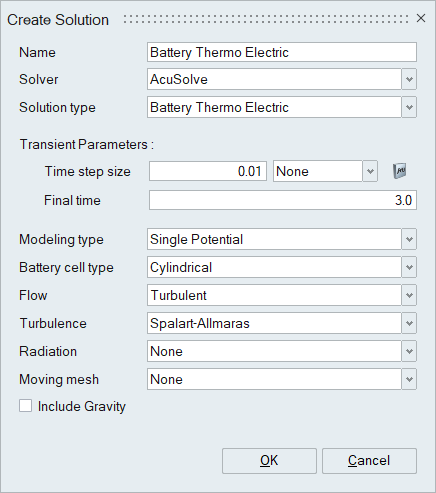Battery Thermo Electric (AcuSolve)
![]()
Introduction
- Battery cell core modeling: The cell is modelled as a homogenized region, where the battery voltage response and associated heat generation are determined using the solution of an ODE system. The solution utilizes two approaches single potential and Multi-Scale Multi-dimensional (MSMD).
- Charge Conservation: In electrically conducting components (e.g. connectors, busbars, and terminals), the charge conservation equation is solved and coupled to the energy equation as a source term.
- Transient thermal conduction: Transient thermal conduction in all cell/module/pack components is solved using the energy equation.
- Cooling: Optionally, the Navier-Stokes equation can be included to design and enhance cooling systems
Collectively, the components allow comprehensive analysis and optimization of the thermal and electrical performance of battery systems.
Two overarching methods are employed in the thermo-electric battery solution: Single potential and Multi-Scale Multi-Dimensional (MSMD). The former solution is applicable for all battery types (e.g. cylindrical cells, prismatic and pouch-type cells), whilst the latter is only applicable for pouch cells. Each approach solves a variant of charge conservation and the energy equation for the batteries:

- Single potential: This approach uses Equivalent Circuit Models (ECM) to characterize the voltage-current response. From the ECM, a source term can be derived and applied to the energy equation and boundary conditions based on current and terminal voltage drop for charge conservation in the connected components of the batteries, e.g. terminals/tabs, busbars, and any other electrically conducting component.
- MSMD: This approach employs a multi-scale method, with a cell scale and a sub-domain scale. On the cell scale, two potential fields represent the potentials of the negative and positive current collectors. The sub-domain model (currently only supporting ECM models) represents the voltage-current response of the battery derived from the solution of an ODE system. Inter-domain coupling between the sub-domain and cell scale is achieved via averaging source terms to eliminate any spatial dependence, in the dual electric potential fields and the energy equation. Cell scale to sub-domain coupling is achieved using spatially resolved variables directly in the sub-domain equations.
The ECM models supported are first, second and third order, where the former has the advantage of simplicity (e.g., fewer parameters), and the latter two give a more accurate battery cell voltage response.